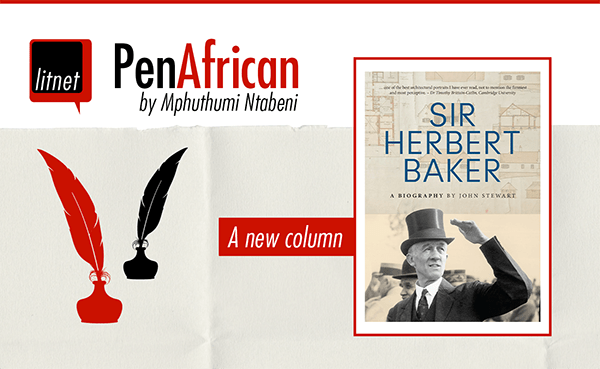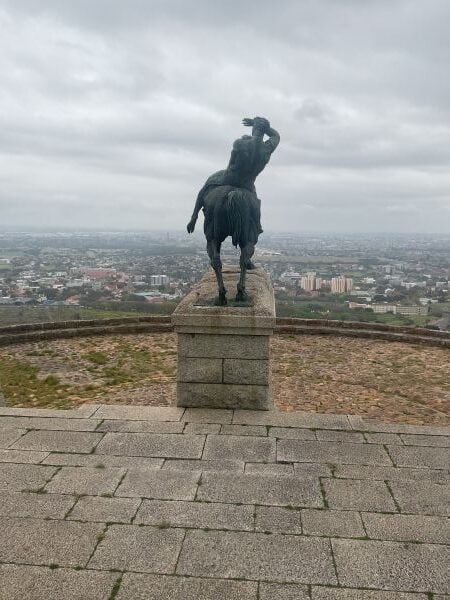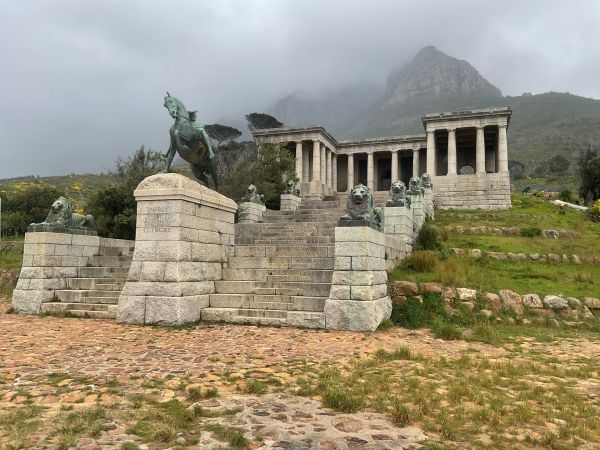
Book cover: Sir Herbert Baker: a biography by John Stewart (Jonathan Ball, 2025)
- Mphuthumi Ntabeni writes a regular book column for LitNet.
Title: Sir Herbert Baker: a biography
Author: John Stewart
Publisher: Jonathan Ball (February 2025)
ISBN: 9781776194162
Sir Herbert Baker (1862-1946) was one of the most prolific architects of the British Empire. His buildings, from the Union Buildings in Pretoria to the Secretariat and Parliament House in New Delhi, and numerous monuments and civic structures in Cape Town and Johannesburg like St George’s Cathedral, continue to dominate the landscapes of former colonies. They function both as architectural achievements and enduring symbols of the imperial order that commissioned them.

Sir Herbert Baker: a biography by John Stewart (Jonathan Ball, 2025)
John Stewart’s Sir Herbert Baker: a biography sets out to reconstruct the career of this “loyal and committed servant of imperial Britain”, whose works, Stewart claims, “celebrated what he sincerely believed to be its benign, civilising influence around the globe” (5).
To say that the tone of the book disturbed me would be an understatement. I put the book aside several times, even vowing never to return to it, but later changing my mind. What enabled me to continue reading the book was a realisation that Stewart is sometimes writing and quoting with a sense of irony at Victorian-age smug. The book is modestly researched, with obvious access to Baker’s family archive. It is elegantly written also, but I doubt it would be used for much architectural referencing due to lack of source harvesting that meets academic requirements.
The early chapters, tracing Baker’s upbringing in Kent, his education at Tonbridge and his professional formation through apprenticeship and evening study in London, offer a clear and engaging portrait of the making of a Victorian architect. Stewart’s reconstruction of Baker’s training under George Gilbert Scott, leader of the Gothic Revival, is particularly valuable, situating Baker within a recognisable lineage of nineteenth century British architectural culture. It also explains his love for ecclesiastical architecture and gothic traits.
.......
What bugged me most about the book was Stewart’s interpretive framework. It is shaped by an uncritical acceptance of imperial ideology, even as he softly mocks it sometimes.
.......
What bugged me most about the book was Stewart’s interpretive framework. It is shaped by an uncritical acceptance of imperial ideology, even as he softly mocks it sometimes: “either bringing civilisation to further tribes of barbarians or promoting the industrial-scale removal of most of their natural assets, depending largely on the date of one’s viewpoint”. Stewart’s rhetorical strategy here is notable in presenting colonialism as a matter of “viewpoint”. This way, he naturalises colonial violence and exploitation, collapsing questions of power and dispossession into questions of personal opinion rather than a historical perspective of plunder and violence. Of course, the book is not supposed to be an interrogation of the former British empire. But in containing biographical facts about Baker, the book is compelled to examine Weltanschauung and the zeitgeist of his era, even criticise his moral and political imperatives, and not just to acquiesce to them or justify them as an unfortunate narrative of the Weltbild of the era.
In my opinion, the biography consistently misses opportunities to interrogate the moral structure of Baker’s career. Baker’s fortunes were closely tied to the patronage of Cecil John Rhodes, whose extractive capitalism, land dispossession and reliance on racialised labour shaped the economic and political landscape of southern Africa. Yet, in Stewart’s account, Rhodes appears not as an instrument of British mercantilism, but an enabler of opportunity, a benign “imperial power” or career capitalist booster rather than a figure whose fortune and influence were grounded in violent expropriation. The subtitle, Rhodes’s architect, would not have been amiss for Baker, but apt and more historically honest. Obviously, Stewart felt that it would be too limiting of his achievements, especially post the death of Rhodes. Fair enough. But this doesn’t change the fact that without Rhodes, Baker would not have had the career reach he later obtained. The professional practice of architecture is heavily dependent on networking for work. The Randlords, politicians and businessmen he later worked for engaged him because he carried the endorsement and legacy of having been a friend and associate of Rhodes. Presenting Baker as just a “neutral classist” and his cohorts – The Kindergarten – as talented men of genius and vision who were God’s given gift to Africa, is not only disingenuous, but offensive to those who were/are by dispossession of their colonial mischief and imperial plunder.
Equally troubling is Stewart’s handling of John Ruskin’s 1870 Oxford lecture that exhorts England to “find colonies as fast and as far as she is able”. Presented in the biography without any critical framing, Ruskin’s racial nationalism and unabashed advocacy of imperial expansion are permitted to stand as though they were a legitimate source of moral inspiration shaping the ethos of Baker’s generation. The effect is subtle, but significant. By reframing this as “idealism” rather than as ideology, Stewart risks grants empire a kind of retrospective moral exoneration. This rhetorical pattern of substituting the lofty vocabulary of idealism for the stark realities of domination, dressing up extraction as destiny, reappears throughout the narrative. It echoes the strategies of Baker’s contemporaries, including his friend and frequent visitor Rudyard Kipling, whose notorious invocation of the “white man’s burden” clothed colonial violence in the language of civilisational duty.
........
From the wars and land dispossessions of southern Africa to the ongoing tragedy of Palestine in the Middle East and the upheavals in Asia and the Americas, Britain’s imperial legacy is still a source of continuing global crisis everywhere.
........
To dismiss this as the relic of a bygone age would be a mistake. One need only listen to contemporary Conservative politics in Britain, with its historical revisionism and endless, myopic evasions of the empire’s catastrophic role in shaping the modern world. From the wars and land dispossessions of southern Africa to the ongoing tragedy of Palestine in the Middle East and the upheavals in Asia and the Americas, Britain’s imperial legacy is still a source of continuing global crisis everywhere. What makes this even more troubling is the refusal of the British public, by and large, to acknowledge the toxic afterlife of their so-called empire. This refusal constitutes one of the central conundrums of the postcolonial era. The wound is not only historical, but ongoing. And, in a cruel irony, the empire’s apologists today increasingly enlist black and brown political representatives from former colonies to defend Britain’s imperial past. Their role, one might say, is to launder empire’s image from within, performing for the nation what in the ugliest of terms was once demanded of “house niggers”.

A view from the Rhodes Memorial in Cape Town (photo: provided)
For scholars of architectural history, Stewart’s biography will have value beyond as a compendium that traces Baker’s career trajectory in detail, outlining his professional networks and charting the evolution of his stylistic vocabulary. As a reference work, I’m afraid, it won’t be useful beyond that. What the book does not provide is the critical apparatus required to situate imperial architecture within its true domain as a technology of power. Architecture, particularly in colonial contexts, was never neutral. It functioned as a shelter and ornament of ideas, and as an instrument in the making and maintenance of empire. Buildings and monuments work as material embodiments of ideology. They are implicated in the organisation of social hierarchies, the projection of authority and the monumentalisation of conquest. Even today, to walk through colonial cities like Cape Town is to move through a spatial grammar that teaches you who belongs, who ruled and who was excluded.
.......
The monument is not merely an aesthetic gesture; it is a physical enshrinement of colonial domination, a spatial inscription of Rhodes’s power in the very geology of Table Mountain’s flank.
.......
Baker’s oeuvre exemplifies this dynamic with striking clarity. His works were not simply architectural achievements, but political statements translated into stone. One need look no further than the Rhodes Memorial, designed and erected on the mountain slopes near the University of Cape Town, to commemorate his patron saint. The site itself is telling, perched high above the city, with the monument framed by classical columns and bronze lions. The monument was intended to naturalise Rhodes’s vision of dominion, and to present an acropolis of empire gazing down over Cape Town and the territories beyond, to Cairo, as their dream demanded. The monument is not merely an aesthetic gesture; it is a physical enshrinement of colonial domination, a spatial inscription of Rhodes’s power in the very geology of Table Mountain’s flank. In its marriage of classical style, Egyptian temple shrine imagery and African landscape, it sought to legitimise conquest by cloaking it in the mantle of timeless civilisation.

The Rhodes Memorial in Cape Town (photo: provided)
This symbolic violence was not lost on those who later sought to resist it through the Rhodes Must Fall movements and others that erupted in 2015. Students and activists understood instinctively that statues and monuments are not inert relics of the past, but active participants in shaping cultural memory and social order. The act of cutting off the nose of Rhodes’s statue to metaphorically spite his colonial face was no mere vandalism for its own sake, but a deliberate counter-monumental gesture, a refusal to let colonial authority remain literally and figuratively on its pedestal. By desecrating the statues, protestors were dismantling the symbolic apparatus of empire, declaring that its claims to permanence could be undone, its granite certainties fractured and its authority unseated.In this sense, Rhodes’s memorials and statues reveal the double life of colonial architecture: erected to eternalise power, yet always vulnerable to the counterclaims of those who refuse to inhabit the order it prescribes. The very fact that Rhodes’s stone visage could be toppled, that his granite throne could be turned into a site of contestation, demonstrates how architecture itself becomes a terrain of political struggle, where memory, legitimacy and justice are continually renegotiated.
........
[T]he work contributes less to the project of critical historiography than to the well-worn tradition of imperial apologetics, a tradition in which architecture is celebrated for its grandeur while its role in legitimising dispossession, segregation and exploitation is quietly elided.
........
By accepting and presenting Baker’s framing architecture as merely a part of a civilising mission, Stewart’s biography misses the opportunity to interrogate these dynamics. He risks reinforcing the narratives of its subject, presenting the buildings only as expressions of lofty ideals rather than as instruments of imperial hegemony. In doing so, the work contributes less to the project of critical historiography than to the well-worn tradition of imperial apologetics, a tradition in which architecture is celebrated for its grandeur while its role in legitimising dispossession, segregation and exploitation is quietly elided.
In sum, Sir Herbert Baker: A biography offers a detailed and accessible narrative of Baker’s life, but one that reproduces rather than interrogates the ideological structures in which his architecture was embedded. I didn’t really get to know the personality of Baker through the book, except for the protracted study of his relationship with his erstwhile collaborator Edwin Lutyens. Their fraught partnership, moving from friendly to bitter, is a central thread of Stewart’s study. It is illuminated by newly available family correspondence that mostly reveals Lutyens’s vindictiveness, soft-padding Baker’s culpability. There is also the case of Baker’s fallout with Massey, which is partially touched on, with soft allusions to Massey’s complaints that Baker frequently omitted to mention his contributions, especially on the Marks Building project. It is common in architectural practice for the principal to take recognition for the design team’s work. But it is equally a moral imperative to acknowledge the architect who did the sketches, which is usually the vision and outlook of the project, even if the overall design is a team effort. In our era, most of the design details are done by computer programmes like CAD, which makes it even more imperative that the sketcher be acknowledged for their aesthetic and original vision. Hence I am of the opinion that Massey had legitimate complaints against Baker.
Stewart’s book is effectively supposed to challenge longstanding criticisms, like Nikolaus Pevsner’s describing him as “naïve and arrogant”. The Baker of Stewart is more complex and resilient, but one doesn’t really know what to do with the evidence of his quarrelling with other professional colleagues and in personal friendships. It would seem that there was something insufferable about his personality, which comes through even in Stewart’s book, despite attempts to muffle it.
Baker established himself as the Empire’s colonial architect par excellence. His Union Buildings symbolised British-Afrikaner reconciliation after the Boer War, while his subsequent commissions in Britain and India brought him into direct conflict with Lutyens over style, authorship and credit. Stewart’s narrative shows how Baker’s architectural discourse, adaptability to local climate and traditions, and ability to realise monumental projects gave him a good reputation, rightfully so. Nonetheless, many professional architects believe that Lutyens outshines Baker in legacy and talent. Lutyens definitely had better natural acumen for more original sketching and design than Baker. Those seeking a critical history of architecture and empire will need to supplement this unbalanced book with more analytically rigorous scholarship to get more on Baker’s wonderful life and talent.
Also read:
Milner – last of the empire-builders by Richard Steyn: a book review
Hidden Johannesburg by Paul Duncan and Alain Proust, a review
Rhodes moes val: Gedagtes oor dekolonisering en swart historiese agentskap
PenAfrican: A reflection on Journey Kwantu by Vusumzi Ngxande
PenAfrican: In search of Nongqawuse by Treive Nicholas – a book review

